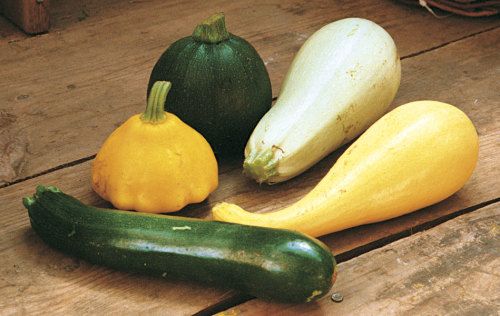
by Susan Jane Cheney
August 2000
from issue #28
Most gardeners can relate a story, verging on the horror genre, about finding a monstrous zucchini that was either totally absent from the vegetable bed or miniscule just hours earlier. Next comes the part about wrestling this unwieldy giant into the kitchen and figuring out a palatable way to prepare it. The prolific and fast-growing nature of these edible members of the gourd family makes them the butt of more jokes than any other vegetable. But there’s a foolproof prescription for summer squash eating enjoyment: frequent picking and quick cooking.
Awash in squash
There are several types and numerous varieties of summer squash. The ubiquitous zucchini comes to mind first. Most are long, cylindrical, and green, but zucchini come in other colors, too. My favorites include the very dark-skinned varieties like ‘Raven’ and ‘Black Beauty’ and the ridged and striped Italian types like ‘Costata Romanesco’ and ‘Cocozelle Bush’. I also like ‘Ronde de Nice’, a round, gray-green French variety.
 |
|
|
Clockwise from top: ‘Eight Ball’ zucchini, Lebanese ‘White Bush’, a yellow crookneck called ‘Sundance’, ‘condor’ zucchini, and the yellow pattypan ‘sunburst’. |
|
Nubbly-skinned yellow crooknecks like ‘Horn of Plenty’ are the squash I recall my Midwestern granny cooking most often. Smooth straightnecks are a newer twist—or untwist—on this classic. One especially tasty straightneck is Zephyr’.
Another familiar summer squash is the scallop-edged, flattened sphere called a pattypan. Again, this type comes in bright sunny yellow, dark green, and creamy pale green varieties.
One of my squash preferences is the pale green Middle Eastern cousa type, of which ‘Magda’ and ‘Clarimore’ are two examples. These are somewhat plumper and more tapered than slender zucchini. Their compact, succulent, mellow “meat” holds its shape well during cooking.
Pick them small
Small is definitely beautiful when it comes to summer squashes. For all summer squash varieties, harvest firm young fruits, preferably either before or just after their blossoms wilt, favoring those that appear bright colored and glossy. These will have a tender texture and well-developed, mild flavor, variously described as sweet, nutty, cucumberlike, delicate, or buttery, depending on the specific variety.
The larger a squash, the tougher it becomes, with seedy, watery flesh and bland flavor. One trick for enhancing an oversized squash is to dice or grate it, sprinkle on some salt, and drain it in a colander for about 20 minutes. Rinse it and press out the excess moisture before cooking.
Summer squashes are particularly perishable, so fresh is definitely best. You can store them, wrapped to keep out moisture, in the refrigerator vegetable bin, but use them within a few days.
| Summer squash recipes: • Zucchini with Zip • Mexican-Inspired Summer Squash Sauté • Moroccan-Style Summer Squash Sauté |
Summer squash are not only gung-ho growers but also versatile resources for summer meals. For cooking, all types are interchangeable, although you’ll no doubt develop favorites for different purposes. Delicate herbs and spices showcase squash’s naturally subtle flavor. But this unassuming culinary chameleon also invites more assertive, vibrant seasonings. Olive oil, garlic, onion, basil, oregano, bell peppers, and tomatoes are among the most traditional squash accompaniments, though almost any ethnic cuisine is fair game for creative experimentation. I’ve played with Moroccan and Mexican flavors in two of my recipes. Squash provides good food value, including vitamins A, C, and B-complex, plus potassium, calcium, and fiber.
Summer squashes are amenable to many cooking techniques, including sautéing, steaming, stir-frying, deep frying, grilling, roasting, stewing, simmering in soups, stuffing and baking, and even pickling. Grated squash contributes moistness to breads and other baked goods. Quickly prepared sautés especially suit the summer season, and the required bit of cooking oil enriches squash’s low-fat flavor.
In sautés, size matters
 |
|
|
For sautés, cut the vegetables into small pieces of uniform size. Shown here, from front to back, are julienne, dice, and angled slices (or wedges). |
|
The shape and size of the prepared vegetables directly correlates with sauté cooking time. Left whole or halved, tiny squashes cook through quite rapidly. My recipes feature three especially quick-cooking cuts: dice, angled slices, and julienne. The latter means matchsticks, made most efficiently by cutting the whole squash, or other vegetable, into 1⁄8-inch-thick vertical slices, stacking the slices and cutting them into 1⁄8-inch-thick slivers, and then cutting these into shorter lengths. To make angled slices, I cut long squashes lengthwise into quarters or smaller wedges, depending on their diameter, and thinly slice these on the diagonal to approximately equal lengths. A dice, of course, is simply small cubes. Using a consistent cut is visually pleasing, plus the pieces will cook in about the same amount of time.
Have everything ready—vegetables and herbs chopped, oil and seasonings at hand —before you begin cooking. Use a wide skillet or sauté pan to prevent overcrowding, which will result in more of a steamed effect. Sauté means “jump” in French, and that’s what the vegetables should do in the pan. Cook over medium-high heat to quickly seal in flavors, and stir constantly. In practically no time, you’ll have a tantalizing, tasty ending to your squash story.
Fine Gardening Recommended Products

Berry & Bird Rabbiting Spade, Trenching Shovel
Fine Gardening receives a commission for items purchased through links on this site, including Amazon Associates and other affiliate advertising programs.

Chapin International 10509 Upside-Down Trigger Sprayer
Fine Gardening receives a commission for items purchased through links on this site, including Amazon Associates and other affiliate advertising programs.

Razor-Back Potato/Refuse Hook
Fine Gardening receives a commission for items purchased through links on this site, including Amazon Associates and other affiliate advertising programs.



















Comments
Log in or create an account to post a comment.
Sign up Log in